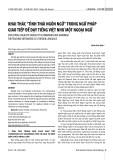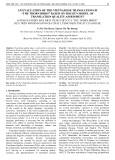
,5(&75()86/&76,1(1/,6+19,(710(6(
BASEDONTHENOVEL“GONEWITHTHEWIND”AND
ITSTRANSLATEDVERSION“CUỐNTHEOCHIỀUGIÓ”
7DQ9DQ7KDW
7KDL9DQQK
(PDLOWKDWWKRHQ
Received:05/08/2024
Revised:17/02/2025
Accepted:26/02/2025
DOI:10.59266/houjs.2025.542
EVWDFWThe article explores direct refusals in English and their Vietnamese
equivalentsthroughacomparativeanalysisofthedirectrefusalsinthenovel“Gonewith
theWind”byMargaretMitchellandtheVietnamesetranslatedversion“Cuốntheochiều
gi”byVũKimThư.Thestudy’sprimaryaimistoexaminehowrefusalsareexpressedin
EnglishandhowtheseexpressionsaretranslatedintoVietnamese,consideringlinguistic
dierences.Inordertoachievethesetaimsandobjectives,descriptiveandcomparative
methodsareemployedandsupportedbyqualitativeandquantitativemethodswithdata
including 87direct refusals.Thendingssuggestthatthecore component thatplaysa
HQWD RH LQ WKH VWWH HSHVHQWLQ GLHW HVDV LQGHV QHDWLH RGV DQG
words with negative connotations. In terms of constructive methods, both languages
RPPRQVHQHDWLHRGVVKDVQRQRWQHHQRWKLQQRLQWHHVWLQ(QLVKDQG
khng,thi,...inVietnamese.Besides,nodataforthedirectrefusalactswiththenuclearas
performativeverbswerefound.Thisresearchalsoprovidesvaluableinsightsforlanguage
WHDKHV HDQHV DQG VKRDV LQWHHVWHG LQ WKHLQWHVHWLRQ R DQDHWH DQG
RPPQLDWLRQ
.HRVVSHHKDWVHVDGLHWHVDRQHLWKWKH:LQG
HanoiOpenUniversity
Post-graduatestudent,HanoiOpenUniversity
,,QWURGFWLRQ
Whileintegrationandglobalization
drive comprehensive development, a
signicant gap remains in the ability of
most Vietnamese people to eectively
communicateinEnglish,askillessential
for participating in global aairs.
Prociency in communication goes
ERQPUOLQJLVLFNQROJLDOVR
UTLUV D S QUVDQLQJ R VRFLDO
andculturalcontexts.
As a vital speech act in everyday
communication, refusal plays a central
role in how individuals navigate
interactions.Therearenotablesimilarities
and dierences in the way refusals are

expressedinEnglishandVietnamese.For
ODUQUV R(QJOLVKDV DVFRQODQJDJ
(ESL)orVietnameseasaforeignlanguage
(VFL), mastering refusal strategies is
crucial for avoiding misunderstandings
and ensuring smooth communication.
Inadequaterefusals,whetheroverlyblunt
or excessively evasive, can result in
confusionorsocialdiscomfort.
Although several studies have
analyzed speech acts in literary works,
research focusing specically on refusal
acts remains scarce. This gap in the
OLUDU KLJKOLJKV K Q RU UKU
investigation. Our study aims to ll
KLV JDS E DPLQLQJ (QJOLVK UVDOV
and their Vietnamese equivalents in the
bilingual text of “Gone with the Wind”
byMargaretMitchellandtheVietnamese
translatedversion“Cuốntheochiềugió”
byVũ Kim Thư. By doing so, we hope
to provide Vietnamese learners with a
FODUUQUVDQLQJRUVDOVUDJLV
and their cultural nuances, enhancing
ERK KLU ODQJDJ VNLOOV DQ FURVV
cultural communication. This research
is particularly valuable as it addresses
DQ VVQLDO QUSORU DVSF R
language acquisition, oering insights
LQR K SUDFLFDO V R UVDOV LQ UDO
worldinteractions.
,,/LWHUDWUHUHYLH
2.1.Overviewofspeechacts
6SFK DF UUV R DQ DFLRQ KD
isperformed when making anutterance,
for example, giving orders and making
promises (Austin, 1962). Searle (1969)
shares,“Speechactsarethebasicunitof
linguisticcommunication.”
Austin (1962) lists ve categories
R VSFK DFV Verdictives, Exercitives,
Commissions, Expositives, and
Behavities. In addition, Searle (1969)
SURSRVV D DRQRP KD KU DU V
ve basic kinds of action that one can
SURUP LQ VSDNLQJ 5HSHVHQWDWLHV,
LHWLHV, &RPPLVLHV, Expressives,
DQ HDDWLRQV. Accordingly, refusals
EORQJRtheexpressivecategory.
2.2.Refusalspeechact
Refusals are one of a relatively
VPDOO QPEU R VSFK DFV KD FDQ E
FKDUDFUL DV D UVSRQV R DQRKUV
DF UDKU KDQ DV DQ DF LQLLD E K
speaker(Gass&Houck,1999:2).
Refusals,accordingtoSearle(1969),
belong to the category of commissives
EFDVKFRPPLKUVURSURUP
an action (in Félix-Brasdefer, 2008:42).
Beebeetal.(1990)addthatrefusalscanbe
used in responseto requests,invitations,
oers, and suggestions (in Scarcella, p.
55-73).
In the book “English Speech Act
Verbs”,A.Wierzbicka(1987)statedthat
refusal belongs to the FORBID group,
which consists of the following verbs:
forbid,prohibit,veto,refuse,decline…
In the Vietnamese dictionary
“Đại Từ Điển Tiếng Việt”, some verbs
FRQFUQLQJ UVDO LQ 9LQDPV DU
LQUSUDVROORV
Chối:tonegatewhathasbeendone,
HHLHGRKDWKDVWDHQSDHHHQL
it’strue[7;380]
Từchối:QRWWRWDHVRPHWKLQWKDW
hasbeenoeredtoyou[7;1578]
Từ bỏ:WR HQRQH WR LH S
something,toleavesomebody,especially.
Somebodyyouareresponsibleforwithno
intentionofreturning.[7;1785]
Cự tuyệt:to refuse denitely or a
decisiveactsoasnottoacceptaction.Or

athingisgiventoyou.[7;491]
Insummary,refusalisanindividual’s
UVSRQVRUDFLRQRQRDFFSRULVDJU
witharequest,oer,orsituation.Itusually
occurs when the person disagrees, does
not want to participate, or is unable to
meetanotherperson’srequest.
2.3. Classication of refusal
VWDWHLHV
Beebe et al. (1990) established a
7DRQRPR5VDOVKDOLQDVKU
directrefusalstrategiesandelevenindirect
UVDOVUDJLVDSSOLFDEORKFLRQ
of refusal speech acts. The three direct
strategiesinclude:(1)performative,(2)non-
performative, and (3)negative willingness
ability. Conversely, the eleven indirect
strategiesconsistof:(1)expressionofregret,
(2)wish,(3)excuse,reason,orexplanation,
(4) presentation of alternatives, (5)
conditionsforfutureorpastacceptance,(6)
promiseoffutureacceptance,(7)statement
of principle, (8) philosophical statement,
(9)eortstodissuadetheinterlocutor,(10)
acceptancethatservesasarefusal,and(11)
avoidance.Thistaxonomywillserveasthe
DQDOLFDOUDPRUNRUKDDFROOF
inthisstudy.
LHFW HIVDO DFW 5 LQ
(QOLVKDQ9LHWQDPHVH
5LVDQDFKDFODUOSUVVV
the intention of refusal, rejecting a
requestorinvitationbyusingthesurface
structures of language. The listener (L)
directly receives the refusal intention
without any diculty or consideration
fromthespeaker(S).
RUDPSO
S:Wouldyoulikesomewater?
L:Nono!I’mf-fine. ( D i r e c t
refusal)(9,p.164)
In English and Vietnamese, an
UDQF R LUF UVDO VDOO
FRQVLVVRDQFODUKLFKSUVVVK
refusalofintention,negative words,and
development.
(1HJDWLYHRUG121FOHDU
HYHORSPHQW
9TừphủđịnhKHÔNG7jQ
phầncốtlõi+Thànhphầnmởrộng
RUDPSO
S:Let’sgoforadrink.
L:No,,FDQWI’mbusynow.
Điuốngchútgđi.
Khng. Mình không đi được.
Mnhbn.
Ican’t=MnhkhngđiđưcLVK
QFODUKLFKJRVLKNo.
I’mbusynowwiththedevelopment
oftheutterance.
KHQHD
7K QFODU LV K N SDU R K
refusalutterance,whichplaystheroleof
themainspeechact.Itcanbeacomplete
UDQF RU FRPELQ LK 12 DQ K
development.The nuclear can consistof
performativeverbsshowingthemeaning
ofrefusal,suchasrefuse,deny,decline…,
etc.; negative words, such as NO, NOT,
NEVER; ornegativewords withaxes,
suchasIM-;IN-;-LESS;etc…
RUDPSO
-Canyounishthehomework?
-No.It’sLPSRVVLEOH
~Cucthlmxongbitpkhng?
-Không.Khôngthểđược.

KHGHHRSPHQW
The development can be used to
PLQLPL K JU R DFKUDQLQJ
DFV R K LQUORFRUV KQ KU LV D
refusalintheirutterance.Thedevelopment
FRQVLVV R PLQLPLLQJ OPQV DVHV
but…’;‘Sorry,I…’‘It’sverykindofyou,
but…’.
RUDPSO
-Let’sgoforadrink. -HV EW ,
can’tgonow.,PEV
~Điuốngchútgđi. -Ừ,nhưng
bây giờmìnhkhôngđiđược.Mìnhbận
rồi.
‘Yes, but … I’m busy.’ LV V R
PLQLPL K JU R DFKUDQLQJ
DFVKQKOLVQUKDUVKUVDOR
QFODU,FDQWRfromthespeaker.
,,,0HWRGRORJ
7KHVHWWLQRIWKHVW
RQH LWK WKH :LQG LV D URPDQLF
drama and the only novel written by
MargaretMitchell. It isset inJonesboro
and Atlanta, Georgia during the
American Civil War (1861 – 1865) and
Reconstruction, and follows the life of
Scarlett O’Hara, from the utmost luxury
to absolute starvation and poverty, and
URP KU LQQRFQF R KUQUVDQLQJ
andcomprehensionoflife.
0HWKRVRIWKHVW
The main objective ofthe study is
RSORUKRUVDOVDUDULFODLQ
(QJOLVK DQ KR KV SUVVLRQV DU
translated into Vietnamese, considering
K OLQJLVLF QDQFV EQ K
two languages. Therefore, the primary
methods of this study are descriptive
and comparative,complementedbyboth
qualitative and quantitative approaches,
DORQJ LKFKQLTV RUDDFROOFLRQ
andanalysis.
Thedescriptivemethodisemployed
RDPLQKRUVDODFVDUSUVV
in English and Vietnamese, using data
extracted from the bilingual novel RQH
LWKWKH:LQG.
The comparative method is used
to analyze the dierences in the use of
LUFDQLQLUFUVDOVLQERK(QJOLVK
and Vietnamese, based on the bilingual
R RQH LWK WKH :LQGbyMargaret
Mitchell,translatedbyVũKimThư.
Supporting qualitative and
quantitative methods will be applied for
dataanalysis.Oncethedataiscollected,
L LOO E FDJRUL DQ DQDO R
facilitateacomprehensivedescriptionand
comparison,whichwillformthebasisof
thestudy’sconclusions.
DWD FROOHFWLRQ DQ DWD
DQDOVLV
Regarding material selection, the
DKRUV V K FRSULJK ERRN R K
bilingual“GonewiththeWind”byMargaret
Mitchell and its Vietnamese-translated
version,“CuốnTheoChiềuGió”.
7K DD FROOFLRQ DQ DQDOVLV
SURFVVKDVEQFDUULRLQRUPDRU
stepstoachievetheseaimsandthestated
objectives.
- Firstly, collect all the data on
UVDO DFV LQ (QJOLVK DQ 9LQDPV
fromMargaretMitchell’sbilingualnovel
GonewiththeWind.
-Secondly,thedatamustbeanalyzed
DQFDJRULLQDLOLQUPVRSV
andmeansofrefusals.
-Thirdly,analyzing,andcomparing
KPDQVRUVDODFVLQ(QJOLVKLK
referencetoVietnamese.

-Finally,discussingthendingsand
VJJVLQJVRPLPSOLFDLRQVRUODUQLQJ
DQDFKLQJUVDOVR9LQDPVODUQ
ersofEnglish.
,90HDQVRIGLUHFWUHIVDODFWVGUD
LQHQJOLVFRPSDUHGLW9LHWQDPHVH
Inthenovel“Gonewiththewind,”
KU DU VQQFV SUVV LUF
refusalacts,accountingfor51,5%ofthe
total number of refusals, which will be
seenclearlyinthefollowingtable.
Table1:FindingofDRAinEnglishcomparedwithVietnamese
0HDQVRIGLUHFWUHIVDODFWV (QJOLV 9LHWQDPHVH
3 ) 3 )
7HGLUHFW
UHIVDODFWLW
WHQFOHDU
Thedirectrefusalactswiththenuclearasperformativeverbs
Thedirectrefusalactswithnuclearasnegativewords 40.23 39.08
Thedirectrefusalactswithnegativewords,andthenuclear 8.05 9.20
7HGLUHFW
UHIVDODFWV
LQFOGHWH
QFOHDUDQG
GHYHORSPHQW
Thedirectrefusalactswiththedevelopmentasreasonor
SODQDLRQ 31.03 31.03
Thedirectrefusalactswiththedevelopmentshowingregret 3.45 3.45
Thedirectrefusalactswiththedevelopmentshowing
DJUPQ 5.75 5.75
Thedirectrefusalactswiththedevelopmentexpressing
goodwillintheformofgivingthanks 11.49 11.49
727/
7KH5VLWKWKHQFOHD
KH 5V LWK QHD DV
QHDWLHRGV
(1):Butler:-Itisquitewarminhere,
hesaid.‘NowonderMissO’Haraisfaint.
MayIleadyoutoawindow?
6FDUO1R.(6,p.171)
Butler: - Ở đy nng qu, c
O’Haraamtlphải.Ticthdẫnc
tớicửasổ.
Scarlett:-.KQ.(5,p.174)
The conversation took place
betweenRhettButlerandScarlett.Scarlett
hadneverthoughtofmeetingRhettButler
again,whohadmockedherinthelibrary
at Ashley’s house. She thought, among
millionsofpeopleintheworld,shecould
notmeetthisdisgustingperson.Shesank
downintothechair.Melaniethoughtshe
wastired.HeoeredtoleadScarletttothe
windowtohelpwiththeheat.
7K LQLLDLQJ DF R K
conversation above isan oer.It canbe
VQ KD 6FDUO DV UVLQJ 5KV
oerHDGWRDLQGRInbothEnglish
andVietnamese,thisisthedirectrefusal
act with the nuclear - negative word
“NO”. InVietnamese, it is expressed by
the equivalent word “KHÔNG”.Scarlett
gavetheclear-cutrefusaltoRhett’soer.
KH 5V LWK QHDWLH
RGVDQGWKHQHD
(2):‘Miss.Pittypat:-Oh,Melly,do
youthinkI’dbetterwriteHenryanoteand
askhimtospeaktoCaptainButler?
Melanie:-1R,GRQW,saidMelanie
(6,p.224)
Miss. Pittypat: - Melley, chu c
thấyccầnphảiviếtchoHenrybảochú
ấynivớithuyềntrưngRhettkhng?
Melanie: - Không, cháu không
muốnvậy.(5,p.228)








![Phương pháp dóng hàng câu tự động cho văn bản Trung Quốc cổ điển - Việt Nam hiện đại [chuẩn SEO]](https://cdn.tailieu.vn/images/document/thumbnail/2025/20250715/nomoney11/135x160/99021752553566.jpg)


![Bộ câu hỏi trắc nghiệm Văn bản tiếng Việt [chuẩn nhất]](https://cdn.tailieu.vn/images/document/thumbnail/2025/20251127/thuynhung051106@gmail.com/135x160/24021764296609.jpg)


![Bài giảng Ngôn ngữ học đối chiếu Nguyễn Ngọc Chinh [PDF]](https://cdn.tailieu.vn/images/document/thumbnail/2025/20251101/vovu03/135x160/7471762139652.jpg)







![Ngân hàng câu hỏi môn Tiếng Việt thực hành [chuẩn nhất]](https://cdn.tailieu.vn/images/document/thumbnail/2025/20251003/kimphuong1001/135x160/21861759464951.jpg)
![Bài giảng Văn học phương Tây và Mỹ Latinh [Tập hợp]](https://cdn.tailieu.vn/images/document/thumbnail/2025/20251003/kimphuong1001/135x160/31341759476045.jpg)


